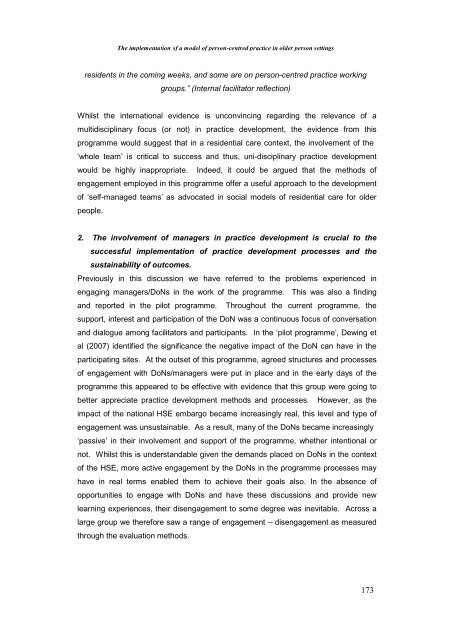The Implementation of a Model of Person-Centred Practice In Older ...
The Implementation of a Model of Person-Centred Practice In Older ...
The Implementation of a Model of Person-Centred Practice In Older ...
Create successful ePaper yourself
Turn your PDF publications into a flip-book with our unique Google optimized e-Paper software.
<strong>The</strong> implementation <strong>of</strong> a model <strong>of</strong> person-centred practice in older person settings<br />
residents in the coming weeks, and some are on person-centred practice working<br />
groups.” (<strong>In</strong>ternal facilitator reflection)<br />
Whilst the international evidence is unconvincing regarding the relevance <strong>of</strong> a<br />
multidisciplinary focus (or not) in practice development, the evidence from this<br />
programme would suggest that in a residential care context, the involvement <strong>of</strong> the<br />
‘whole team’ is critical to success and thus, uni-disciplinary practice development<br />
would be highly inappropriate. <strong>In</strong>deed, it could be argued that the methods <strong>of</strong><br />
engagement employed in this programme <strong>of</strong>fer a useful approach to the development<br />
<strong>of</strong> ‘self-managed teams’ as advocated in social models <strong>of</strong> residential care for older<br />
people.<br />
2. <strong>The</strong> involvement <strong>of</strong> managers in practice development is crucial to the<br />
successful implementation <strong>of</strong> practice development processes and the<br />
sustainability <strong>of</strong> outcomes.<br />
Previously in this discussion we have referred to the problems experienced in<br />
engaging managers/DoNs in the work <strong>of</strong> the programme. This was also a finding<br />
and reported in the pilot programme. Throughout the current programme, the<br />
support, interest and participation <strong>of</strong> the DoN was a continuous focus <strong>of</strong> conversation<br />
and dialogue among facilitators and participants. <strong>In</strong> the ‘pilot programme’, Dewing et<br />
al (2007) identified the significance the negative impact <strong>of</strong> the DoN can have in the<br />
participating sites. At the outset <strong>of</strong> this programme, agreed structures and processes<br />
<strong>of</strong> engagement with DoNs/managers were put in place and in the early days <strong>of</strong> the<br />
programme this appeared to be effective with evidence that this group were going to<br />
better appreciate practice development methods and processes. However, as the<br />
impact <strong>of</strong> the national HSE embargo became increasingly real, this level and type <strong>of</strong><br />
engagement was unsustainable. As a result, many <strong>of</strong> the DoNs became increasingly<br />
‘passive’ in their involvement and support <strong>of</strong> the programme, whether intentional or<br />
not. Whilst this is understandable given the demands placed on DoNs in the context<br />
<strong>of</strong> the HSE, more active engagement by the DoNs in the programme processes may<br />
have in real terms enabled them to achieve their goals also. <strong>In</strong> the absence <strong>of</strong><br />
opportunities to engage with DoNs and have these discussions and provide new<br />
learning experiences, their disengagement to some degree was inevitable. Across a<br />
large group we therefore saw a range <strong>of</strong> engagement – disengagement as measured<br />
through the evaluation methods.<br />
173
















